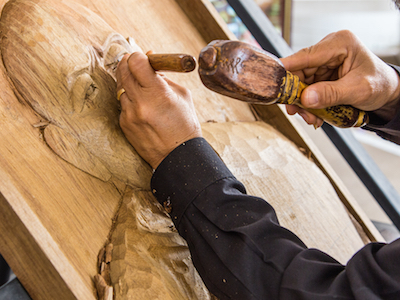a.k.a. Extrinsic vs. Intrinsic Motivators
Imagine setting foot in your office one morning and you see one of your star employees. He’s dressed in a nice suit, filling up his coffee mug to the brim, and already solving company problems over the phone. You’re probably thinking, “How much more money should I give this person so he or she doesn’t leave?” But behind every talented employee’s collared shirt, coffee mug, and smartphone, there’s a soul that yearns for something money can’t buy. The only solution to retain your top talent is by using intrinsic motivators.
So buckle up. It’ll be an interesting ride. But first, let’s stop for gas and talk a bit about the old-fashioned way of motivating someone - by paying him or her more money. This way of motivation is called “extrinsic,” and for good reason: it comes from the outside.
Extrinsic Motivation:
Carrot and Stick Conundrum
There used to be a time when a manager would routinely wield his mighty pen and punish an employee who was underperforming, by slashing their paycheck accordingly. Or, when they over-performed, use his magical pen once again to sign a check for a bonus. This was because back then the workforce was comprised mainly of men and women daydreaming about a better life, instead of performing highly qualified, extremely intellectually-demanding tasks, such as sealing tuna cans on the floors of sweatshop-like factories. I’m surprised they didn’t use actual whips to make them work harder.
For automatic or algorithmic work that basically required repeating a pre-defined series of steps, this external type of motivation made sense. Give them more money and they’ll repeat that series of steps faster and for longer. But for jobs that required a new solution every single time, like an SEO expert or a copywriter, this approach is devastating. The imaginary whip stifles creativity and imagination and leads to superficial or flawed work. Keep whipping or giving them carrots, and they’ll get frustrated, do half-baked work, and eventually leave, looking for a better workplace environment.
That’s because these people are driven by something else, something called intrinsic motivation. They want to do the job because they find it inherently fun, challenging and rewarding. Money comes second. Learn to create a workplace where they can experience this, and you’ll be able to retain your top talent. I promise.
Intrinsic Motivation:
Microscopic Foundation
To better understand intrinsic motivation, we need to put it under a microscope and see what it’s made of. Once you learn how to create a work environment that’s addictive to your employees, you’ll retain your top talent, for sure.
According to Daniel Pink, author of Drive: The Surprising Truth About What Motivates Us, these ingredients are: autonomy, mastery and purpose. So let’s hit the road and look at each of them in turn. You’ll learn how to apply these ingredients to retain your top talent and keep them sealed to your company’s chair for the long haul.
Autonomy - The Freedom Aspect

This means letting your employees who perform creative, experiential work choose what they want to do, when they want to do it, how they want to do it, and with whom. Why? Because we all have our own ways of solving problems. Assembling cars is an “algorithmic” job that requires minimal creativity and lots of pre-defined rule following. But designing a car is purely creative, requiring imagination and vision.
In the first case, you can demand them to do the job in a specific way and within a certain time-frame, but in the second, you must let them do their own thing. This way, you can retain your top talent by unlocking their full potential. You’ll see great results. It doesn’t always work - hence the Toyota Prius - but when it does, you’ll hit the jackpot.
This doesn’t mean you can’t give them guidelines or tell them what you’re expecting from them - quite the contrary. They need to know what results you’re aiming for, but after that, you have to let them do their own thing. Without autonomy, your employees won’t feel at ease when working. They’ll always have to follow rules they don’t like and give explanations for their actions. Yuck. Instead, only ask for a specific result and let them play.
Great. Now let’s continue our journey. Next stop: mastery.
Mastery - It’s What Keeps Them Going

We want to get better at what we do - it’s in our blood, and it’s what gets us out of bed in the morning and makes us rush to work, without secretly wishing our boss would get hit by lightning.
For example, thousands of years ago, hunters got tired of getting injured when trying to take down an animal. Since there was no Medicare back then, they had to figure out a way to stay out of trouble while hunting. So they made a knife out of flint. That gave them a pretty good edge over their prey. Sure, you couldn’t win Cutthroat Kitchen with it, but it was better than nothing. Years passed and people wanted more durability, precision, and chicken breast fillets. Knives were made more slender and more svelte. They were upgraded from bronze to copper, and then finally to the iron and carbon combinations we see today.
Throughout the entire knife evolution, the people making knives wanted to get better at making them. And they did. It’s the desire to get better at making knives that motivated them. In short, the desire for mastery propelled them forward.
Your top talent wants the same thing, so you must give them tasks that will help them master their skills. The trick, however, is to give them tasks that are neither too difficult, nor trivially easy. Too difficult, and they’ll get frustrated and lose interest. Too easy, and they’ll get bored. You have to keep tabs on them and assign tasks that are just right for them to ensure they keep making progress and basking in the joy of improving their skills.
Simple? Simple! Now let’s make our last stop on the road to retain your top talent: purpose.
Purpose - The Final Thing to Retain Top Talent

People who find meaningful purpose in their jobs are the most motivated and less likely to leave a company. Your job as an employer is to sell them a vision in which the world is better with their work.
For example, say you have an employee in your company’s marketing department. You might tell her, “With your work, we’ll make more money and you’ll get promoted.” That isn’t a great motivator. But something like, “With your work, more products will be sold, helping the company expand, generate more work, and create even better products that’ll enrich people’s lives” is a lot better. Sure, it’s a tough sell when your company’s making toilet paper, but you get the idea.
Destination Arrived

Don’t use the carrot and stick approach to retain your top talent. It kills motivation faster than a superhero can catch a speeding bullet. And that’s saying something. The solution to retain your top talent is to create a comfortable work environment by using the principles of intrinsic motivation.
Let your employees do work on their own terms with minimal guidance (autonomy), help them hone their skills (mastery) and sell them a grand reason for their work (purpose), and they won’t leave. They won’t want to. Leaving the comfort zone means change, and change is unnatural and difficult for humans. Plus, there’s no guarantee the next job will ensure the same level of autonomy, mastery and purpose. If the current pay is decent, the risk is just not worth it.
Try this exercise to help you retain your top talent. Write down a list of your employees and figure out which ones are your superstars. See if you’re using the old carrot and stick type of motivation. If you are, you might want to change tactics and try to create a work environment that facilitates intrinsic motivation. It’ll make them less prone to leaving, and best of all, it won’t cost you a thing.
Which of these three tactics do you find the most difficult to implement to retain your top talent? Share your insider tips in the comments below!


